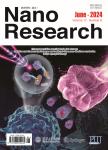Tunable photocycle kinetics of a hybrid bacteriorhodopsin/quantum dot system
作者机构:55 North Eagleville Rd Department of Chemistry University of Connecticut Storrs CT 06269-3060 USA
出 版 物:《Nano Research》 (纳米研究(英文版))
年 卷 期:2019年第12卷第2期
页 面:365-373页
核心收录:
学科分类:0808[工学-电气工程] 0809[工学-电子科学与技术(可授工学、理学学位)] 07[理学] 0805[工学-材料科学与工程(可授工学、理学学位)] 0702[理学-物理学]
基 金:the National Institutes of Health (GM-34548) the National Science Foundation (No. CAREER-1554800)
主 题:bacteriorhodopsin photocycle bionanotechnology photochromism quantum dot hybrid materials
摘 要:The inclusion of inorganic nanoparticles in biological environments has led to the creation of hybrid nanosystems that are employed in a variety of applications. One such system includes quantum dots (QDs) coupled with the photoactive protein, bacteriorhodopsin (BR), which has been explored in developing enhanced photovoltaic devices. In this work, we have discovered that the kinetics of the BR photocycle can be manipulated using CdSe/CdS (core/shell) QDs. The photocycle lifetime of protein samples with varying QD amounts were monitored using time-resolved absorption spectroscopy. Concentration-dependent elongations of the bR and M state lifetimes were observed in the kinetic traces, thus suggesting that excitonic coupling occurs between BR and QDs. We propose that the pairing of BR with QDs has the potential to be utilized in protein-based computing applications, specifically for real-time holographic processors, which depend on the temporal dynamics of the bR and M photointermediates.



